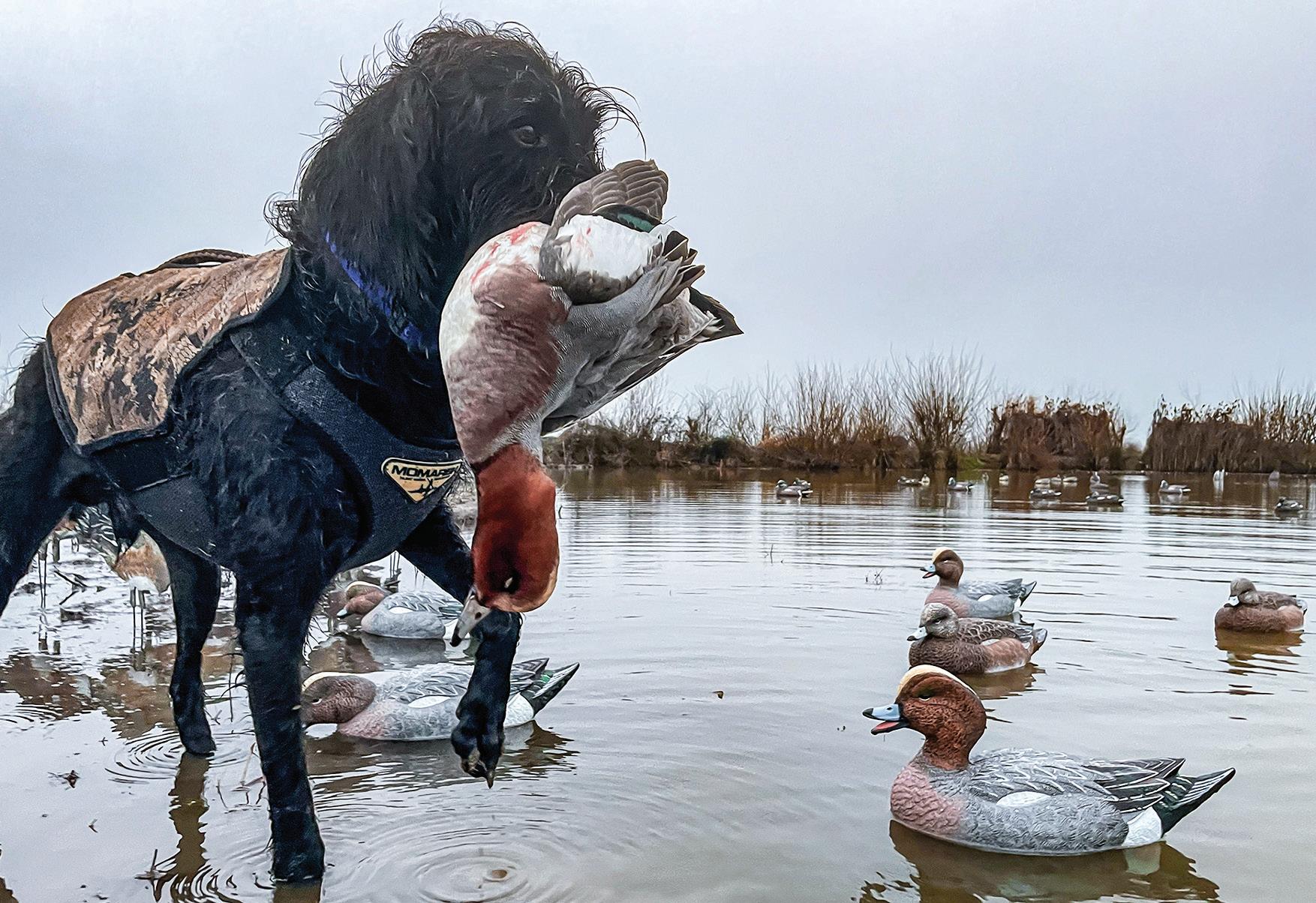








PUBLISHER
James R. Baker
GENERAL MANAGER
John Rusnak
EXECUTIVE EDITOR
Andy Walgamott
EDITOR
Chris Cocoles
WRITERS
Mark Fong, Scott Haugen, Tiffany Haugen, Tim E. Hovey, Cal Kellogg, Mike Stevens
SALES MANAGER
Paul Yarnold
ACCOUNT EXECUTIVES
Janene Mukai, Tom St. Clair
DESIGNERS
Kha Miner, Gabrielle Pangilinan
WEB DEVELOPMENT/INBOUND
MARKETING
Jon Hines
ADMINISTRATIVE ASSISTANT
Katie Aumann
INFORMATION SERVICES
MANAGER
Lois Sanborn
ADVERTISING INQUIRIES media@media-inc.com
CORRESPONDENCE
Email ccocoles@media-inc.com X @CalSportsMan Facebook.com/ californiasportsmanmagazine
ON THE COVER
Jerry Haugen hopes to make the most of the final days of 2024-25’s various waterfowl seasons, many of which in California wrap up this month. Haugen’s son Scott has the details for late-season duck success on page 46. (SCOTT HAUGEN)
MEDIA INC PUBLISHING GROUP 941 Powell Ave SW, Suite 120 Renton, WA 98057 (800) 332-1736 • Fax (206) 382-9437 media@media-inc.com



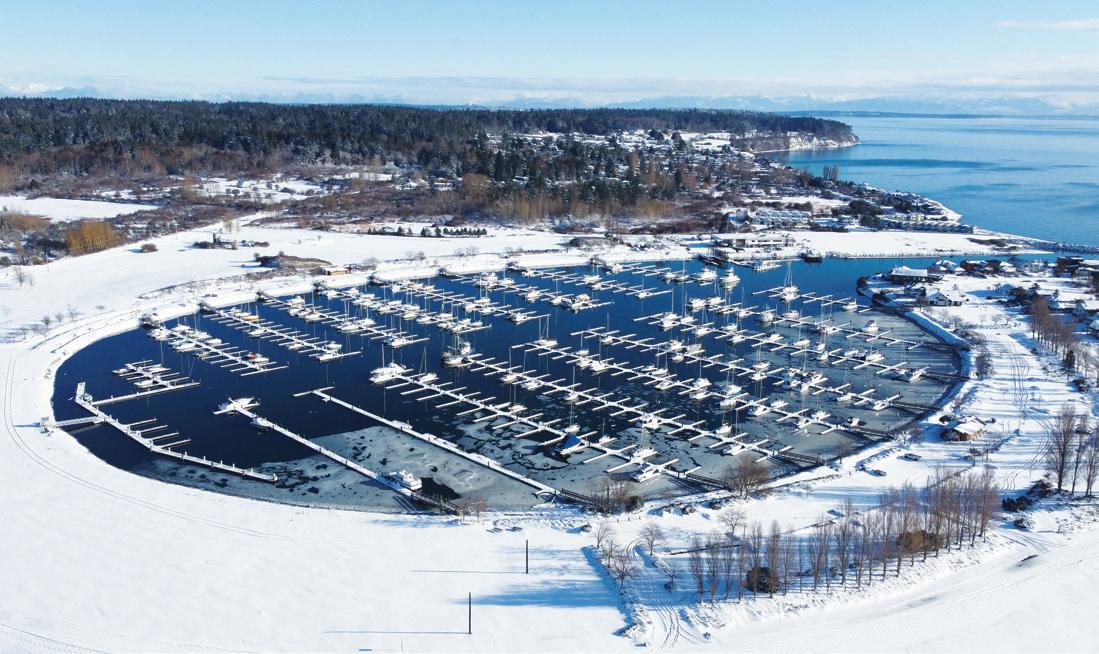




Some of the Sierra foothills’ best fishing takes place at the Mother Lode lakes, and one of Cal Kellogg’s favorites is Lake Amador. It’s a small fishery that’s filled with trophy-sized trout like this fat rainbow. Kellogg breaks down the best tactics and gear choices to tempt big ’bows, lightning trout – known to locals as “Amador golds” – and hatchery-raised cuttbows.

21 EASTERN SIERRA WINTER TROUT WONDERLAND
It’s never too early to start planning for the Eastern Sierra’s last-Saturday-in-April Fishmas trout opener. But if you’re eager to fish the high country well before then, SoCal-based Mike Stevens has you covered with his rundown on good year-round fisheries in and around the Highway 395 corridor. From a stretch of the lower Owens River to Pleasant Valley Reservoir – and even some bonus bass opportunities – bundle up and catch some winter fish!
41 BOOST YOUR LATE DUCK LUCK
As duck season winds down in the Golden State this month, hunting these wised-up birds can get pretty tough. But never fear, our From Field to Fire columnist Scott Haugen shares how to make the most of January’s final chances to score limits of ducks. Between being more mobile, meticulous with your blind setup and cleaning up your calling, you can still find success. Meanwhile, Chef Tiffany Haugen adds a fresh goose recipe for the table.
47 THE GOLDEN GOOSE OF HUNTING OPPORTUNITY
More waterfowl tales of joy from Tim Hovey, whose fascination with all things Canada goose began with his brother in Central California when a flock of honkers dive-bombed into a lake. “They were big, beautiful and loud. And I knew I wanted to hunt them,” he recalls. Thus, hunting this majestic waterfowl species became an annual rite of passage. Check out Hovey’s checklist for bagging some tasty birds.



Having grown up in the temperate climate of the Bay Area, the idea of experiencing all four seasons was never a thing for the locals. Case in point: When I visited around Thanksgiving, on multiple occasions it was sunny and warm enough to warrant T-shirt and shorts attire while walking my dog Olive. Contrast that to where I live now in Seattle, where wearing such light layers on Thanksgiving, Christmas or New Year’s Day would be considered borderline reckless given the Pacific Northwest’s wet, chilly and sometimes snowy conditions this time of year.
Still, our first issue of 2025 – Happy New Year, everyone! – reflects that some parts of California indeed embrace winter and its traditionally frigid conditions. Our correspondent Cal Kellogg and longtime California Sportsman scribe Mike Stevens – making his return to the writing lineup – wrote about winter trout (and even bass) fishing opportunities in the high country (the Truckee area by Kellogg and the Eastern Sierra’s open fisheries via Stevens).
Before I moved to Arkansas to continue my newspaper reporting career, my friend Chris and I did a last fling in the Golden State to Lake Tahoe and Northeast California in early November. We fished, hiked through the snow and stayed at an isolated resort – we caught a few bass in their private fishing pond – where each of our own rooms had an outdoor hot tub, which I soaked in late at night while the outside temperature dipped well under freezing.
I’m admittedly not a big fan of snow that interrupts my daily routine – it’s a pain in the ass to drive in or attempt to walk my high-energy pup along slippery sidewalks. But I have to admit, as long as I don’t have to leave the house, I certainly appreciate the beauty of snowfall. As a kid I only experienced it on weekend trips to the Sierra to ride tubes down bunny hills (an exception being a freak San Francisco snowstorm in the late 1970s that dusted our San Bruno backyard lawn).
Having now lived in three different locales where snow is not quite common
but a distinct probability each winter, I’ve learned to coexist with Mother Nature’s cold spells.
And while my previous two dogs were at best indifferent to the snow, perhaps Olive will be the exception to the rule and embrace Jack Frost rather than reject him. That she was rescued first from Texas and has a newfound obsession with sleeping next to my gas fireplace, such expectations seem unrealistic, however.
But with the new year upon us and the dog days of winter hitting their stride, it’s actually an ideal time to layer up, use care around icy riverbanks and lakefront shorelines and get in some outstanding fishing opportunities.
It might be a skiing-fishing combo trip to the Tahoe area – playing a little blackjack or craps by night at the casinos – or driving up Highway 395 from Southern California to hit the few productive lakes and rivers that remain open until the Fishmas celebration in late April. Either way, it’s never too cold or snowy to enjoy what makes winter in California so unique. -Chris Cocoles

1 Online harvest reporting begins for steelhead and sturgeon
1-March 30 Lake Amador Tagged Trout Derby; lakeamador.com/2024-2025-tagged-trout-derby
3-15
Second white and white-fronted geese season dates in Northeastern Zone
12 Last day of regular Canada geese season in Northeastern Zone
15 Last day of duck and scaup seasons in Northeastern Zone
16-19 Sacramento International Sportsmen’s Expo, CalExpo; sportsexpos.com/attend/sacramento
17-19 Hall Shows L.A. County Boat Show, Pomona Fairplex; hallshows.com
18-19 Northeastern Zone Veterans and Active Military Personnel Waterfowl Hunting Days (ducks only)
26 Last day of most general quail and chukar seasons
26 Last day of general tree squirrel and rabbits and varying hare seasons
27 Start of falconry rabbits and varying hare season
30-Feb. 2 Hall Outdoor Show, Long Beach Convention Center; hallshows.com
31 Last day of duck season in most zones
31 Last day of falconry take of ducks (including mergansers), geese, American coots and common moorhens in most zones
1-2 Youth Waterfowl Hunting Days in Balance of State, Southern San Joaquin Valley and Southern California Zones
1-2, 15-19 Falconry take of waterfowl season dates in Balance of State, Southern San Joaquin Valley (ducks only) and Southern California Zones
1-4
3-9, 12-20
Falconry take of waterfowl (ducks only) season dates in Colorado River Zone
Late white geese season dates in Imperial County
5 Late white and white-fronted geese season opens in Northeastern Zone
8 NorCal Trout Challenge, San Pablo Reservoir; anglerspress.com/events/norcal-trout-anglers-challenge
8-9

Youth Waterfowl Hunting Days in Colorado River Zone
8-9 Veterans and Active Military Personnel Waterfowl Hunting Days in Balance of State, Southern San Joaquin Valley and Southern California Zones
8-12 Late white-fronted and white geese season dates in Balance of State Zone
13-16
Hall Family Super Show, San Diego, Del Mar Fairgrounds; hallshows.com
28-March 2The Fly Fishing Show, Alameda County Fairgrounds, Pleasanton; flyfishingshow.com/pleasanton-ca
28 Last day of falconry seasons for chukar, sooty (blue) and ruffed grouse, and white-tailed ptarmigan
For a list of upcoming bass tournaments, go to nrm.dfg.ca.gov/FishingContests/default.aspx.
Waterfowl season is winding down this month, but there’s still plenty of opportunity throughout January, including a special Northeastern Zone ducks-only hunt for active military personnel and veterans on January 18 and 19. (JOHN CICCARELLI/BUREAU OF LAND MANAGEMENT)

By Cal Kellogg
It was a little too warm to snow and the low overcast was spitting chunky rain. Anglers and gear alike were dripping wet. The ever-present wind made for chilly conditions, but we were dressed for the occasion and reasonably comfortable.
“There’s a pair of trout right there,” master guide Matt Heron said while pointing into the stream’s dark water.
A handful of minutes later, Scott’s indicator jerked down; instinctively, Scott snapped the rod tip upward and
the first trout of the day exploded into a frantic series of runs and jumps.
When the trout lost strength, Scott slid it into Matt’s waiting net. The rainbow was beautiful, with a dark green back and an impressive pinkorange stripe running the length of its body. The fish was about 17 inches long, and after holding the rainbow up for a photo, Matt slid it back into the Little Truckee River unharmed.
Over the years I’ve done a good deal of fly fishing in the Truckee region during summer and fall, but this was the first time I’d done so in winter.
In my mind – and I suspect in the minds of many of the trout anglers reading this article – the words “fly fishing,” “winter” and “Truckee” are totally incongruent, as the region is often the coldest spot in California this time of year. But I’m here to tell you that wintertime fly fishing in the Truckee area is absolutely incredible.
I was shooting video of a group of three anglers, Scott, Fabiano and Abdul, during a two-day December fly fishing adventure. The first day we visited the Little Truckee River, and on day two the guys fished the


mainstem of the Truckee.
I estimate that over the two days the guys hooked around 60 trout and probably landed 70 to 80 percent of them. Most of the trout were rainbows, but we saw a handful of browns too. Many of the fish were 12 to 16 inches, but several rainbows and one brown broke the 20-inch mark.
If you’re a Central or Northern California fly angler who hangs up your gear when fall gives way to winter, you might want to reconsider that strategy because you’re missing out on some top-notch action on the Little Truckee River, the mainstem Truckee River and Prosser Reservoir.

The Little Truckee is an amazing fishery with big numbers of rainbows and browns. It’s a tributary of the Truckee proper, but dams were built on the stream, forming Stampede and Boca Reservoirs.
When fly anglers talk about fishing the Little Truckee, they are talking about the 4.5-mile stretch between where the stream flows out of Stampede and where it enters Boca. Being a tailwater, streamflows are gentle most of the time, ranging from 50 cubic feet per second late in the summer and early fall to 250 cfs in the spring.
While the Little Truckee is officially called a “river,” it’s more of a stream made up of riffles, pockets, flats and small pools. Most of the time wading is easy. When I visited the stream this winter it was flowing at about 180 cfs, and I had zero problem wading while wearing hip boots.
The Little Truckee is insect-rich; this in large part is a function of the bottom composition. Like many Eastern Sierra streams, the Little Truckee flows through volcanic rock. These porous rocks hold and release critical nutrients into the water, leading to a prolific aquatic insect population.
The Little Truckee is less than an hour from Reno and only minutes from Truckee, so it receives a good deal of fishing pressure during the warm months. As a result, the trout are very educated and can be difficult to hook.
Fall and early winter are red-letter days on the Little Truckee because, in addition to resident fish that reside in the stream all year long, an influx of both browns and rainbows move up the stream from Boca Reservoir.
Boca hosts kokanee salmon, which typically spawn during October, and this draws the rainbows and browns upstream to feed on wayward eggs. Next, in late November, the brown trout spawn takes place. Rainbows stack up behind the browns to gobble their eggs.
The bottom line is that during
the fall and early winter, the Little Truckee plays host to the highest total number of trout during the entire year, as well as the largest number of trophy-caliber trout. Better still, most of these fish are in the stream for the purpose of feeding.
Early in the fall, large streamer flies can pay dividends in the form of reaction strikes from big browns following kokanee upriver. Egg patterns are a good bet from the time the kokanee move in until late December when the last spawning browns wrap things up.
If streamers and egg patterns aren’t drawing strikes, small nymphs like Pheasant Tails and Hare’s Ears in sizes 16 to 20 almost always produce fish. A sleeper fly the locals often rely on is a San Juan Worm tied in the traditional red color and other color variations.
Nymph, worm and egg patterns are almost always fished on multiple fly leaders teamed with indicators. This type of fishing is all about working with a short line. Traditional fly casts aren’t employed. Instead, it’s more of a flop-and-drift approach.
It’s critical to maintain a dragfree drift and pay close attention to the indicator. If the indicator does

anything out of the ordinary, set the hook, because the trout will spit the fly with lightning speed when they determine they’ve been duped!
Note that at some point in December, access becomes an issue on the Little Truckee due to snow. The road isn’t cleared beyond Boca
Dam. At this point, the hardest of hardcore anglers continue to fish the stream by utilizing snowshoes and snowmachines for access.
“The Truckee River is one of California’s classic freestone streams,”


says Matt Heron of Matt Heron Fly Fishing (mattheronflyfishing.com).
The stretch of river from the town of Truckee to the Nevada state line is where most serious fly anglers work. This is big water: deep pools, huge rocks, runs, riffles and flats.
The rocks in many areas are large, round and slippery. Combine the lack of solid footing with big flows and you’ve got a recipe for dangerous wading. Caution is the order of the day when wading the Truckee during the winter. If in doubt, a wading staff is a nice piece of equipment to have.
If you surf the internet, you’ll find an endless array of truly huge trout being displayed by lucky Truckee River anglers. Big rainbows and browns in excess of 10 pounds that call the river home have been caught.
However, not only are these trout highly educated in the ways of anglers, but they also have a wide array of forage available to them in the form of crawfish, sculpins, smaller trout and a
full menu of aquatic insects.
As a result, the bite windows for hooking a big trout on the Truckee are often small because the fish are constantly surrounded by forage. And the trout will scrutinize your fly and presentation for any deficiency. In short, if your goal is a Truckee River trophy trout, you’ll need to put in the work and combine it with a side order of luck!
Day in and day out, medium to small nymphs combined with indicators are the most effective way to hook trout of all sizes on the Truckee, but streamers can work well too. Most of the time, it’s quality over quantity here, and this is especially true as late fall gives way to winter.
If you are really focused on big fish, streamers may well be the way to go. You won’t get as many strikes as you will on nymphs, but the strikes you do get will be from big predatory fish.
Streamer fishing on the Truckee is akin to a black bass angler committing
to throwing big swimbaits in an attempt to draw strikes from the largest class of bass residing in the lake.
Outside Truckee there are three reservoirs close at hand: Stampede, Boca and Prosser. If you enjoy stillwater fly fishing, Prosser Reservoir is a great place that is often overlooked by the fly fishing fraternity.
I’ve seen very few fly anglers fishing Prosser, which is unfortunate since the lake is relatively small and packed with both rainbows and Lahontan cutthroats. I’ve scored at Prosser while working flies from the shoreline, but for the best results, a float tube or kayak is a must.
Since the speed limit for motorized boats is only 10 miles per hour at Prosser, kayaking and float tubing feel safer here than at other reservoirs without speed restrictions.
At times when you see trout breaking on the surface, a pair of









small nymphs such as Hare’s Ears, Pheasant Tails or Zug Bugs suspended under an indicator will draw strikes, but I find sitting still and watching an indicator floating on the surface of a lake tedious.
I prefer a more aggressive streamer fishing approach. When working with Woolly Buggers and Jay Fair streamers, I sometimes cast and retrieve flies using a floating line, but more often I employ a sinking line and slow troll the flies from 5 to 10 feet deep with plenty of added twitches and pauses.
The upper end of Prosser features shallow flats and submerged creek channels. This is the area where I’d concentrate if I wanted to fish with nymphs. The deep water out in front of the dam generally holds big
numbers of fish. This is where I like to concentrate on streamer fishing.
Fall – from October through early December – is the best time of the year to fish Prosser. As with the Little Truckee, accumulating snow typically cuts off access to Prosser at some point in December.
The formation of ice is also a factor at Prosser. Some winters you won’t see significant surface ice until the end of January. Other years, snowmobileequipped anglers are ice fishing Prosser as early as New Year’s Day.
If you are new to fishing the Truckee area, hiring a professional guide is money well spent, since a guide will help you avoid mistakes and cut the learning curve significantly.
As I mentioned early on, Matt Heron acted as our group’s guide when we hit the Little Truckee and Truckee in December. Matt is very personable and a skilled instructor. I highly recommend his services if you are visiting the Truckee region and interested in fly fishing.
Matt grew up in New York’s Adirondack Mountains and has degrees in aquatic science and outdoor recreation and management. He relocated to California by way of Montana and has fly fished all over the world. Matt’s knowledge and experience are second to none.
A day spent with him on the water will set you up for success in the Truckee area, and the experience will make you both a more knowledgeable and effective fly angler! CS













By Mike Stevens
New statewide trout regulations took effect in California back in March 2021, and that opened up a fair amount of water that could be fished – with special regulations – on a yearround basis.
It’s always cool to gain more spots to fish, and there are also new factors to consider along with the regs when it comes to these waters. When it comes down to it, in many cases the Eastern Sierra winter angler might be
better served by hitting the lakes and streams that have been open yearround all along.
Anglers should consult the California Department of Fish and Wildlife regulations at wildlife.ca.gov/ Regulations, or scan the basics in ata-glance fashion at MonoCounty.org. There’s just too much to list here, so it’s best to track down “your” waters in the regs. You’ll quickly realize almost all of the easy-access, drive-up “resort”-style lakes between Bishop
and Bridgeport remain on the classic (i.e., not year-round) season schedule of the last Saturday in April through November 15, generally speaking, but there are some surprises there.
Just to touch on it, here is one to consider: Intake II in Bishop Creek Canyon is one of those new winter fisheries, but conditions and access come into play. While the road is plowed all the way there, Intake II does freeze in winter. That being said, there’s usually a short window between the closing of the general season (November 15) and when
the ice arrives.
But where this small lake on Bishop Creek shines as a yearrounder is prior to the late-April opener. Intake II typically ices out by early April, so anglers heading up for the opener have a place to fish if they arrive a day or two prior to Fishmas.
Scrolling the regs will reveal a lot of water that’s now legally open to fish year-round but where access is essentially impossible due to snowcovered roads and the frozen lake itself, so it’s a bit of a head scratcher why CDFW bothered, but here we are. For example, North Lake – also in Bishop Creek Canyon – is open, but that one-lane road is usually not clear for the opener, let alone in winter.
Similarly, several lakes up Tioga Pass like Ellery, Saddlebag and Tioga Lake – they usually don’t ice-off until May or later – are year-round now, along with the bulk of the Eastern Sierra backcountry, but don’t plan on being able to get to them.
It didn’t take long after the new trout regs took hold and opened up new

winter fisheries for Sierra anglers to realize the best “off-season” waters were those that have always been open year-round.
That includes the lower Owens River as it flows through Bishop all the way down to Lone Pine (as far

as where it can be effectively fished). There are no special restrictions on tackle; bait is allowed and five trout may be kept. There is a stretch below Pleasant Valley Reservoir down to Five Bridges Road, known as the Wild Trout Section, that does have special regs for catch-and-release with barbless artificials, but it is open year-round.
PVR itself also offers year-round trout fishing with no special gear or bait regs. There’s also the Owens River Gorge upstream of PVR, where anglers willing to make the steep hike down to the water are typically rewarded with good numbers of smaller brown trout and the occasional 12-plus-inch rainbow. Bishop Creek is also fishable at lower elevations (Bishop proper) where snow doesn’t create access issues.
Closer to the town of Mammoth Lakes, the upper Owens River upstream of Benton Crossing to the headwaters at Big Springs is open all year to zero-limit fishing with artificials and barbless hooks. There isn’t much parking available – less so when there’s snow – so you should plan to do some walking to get away
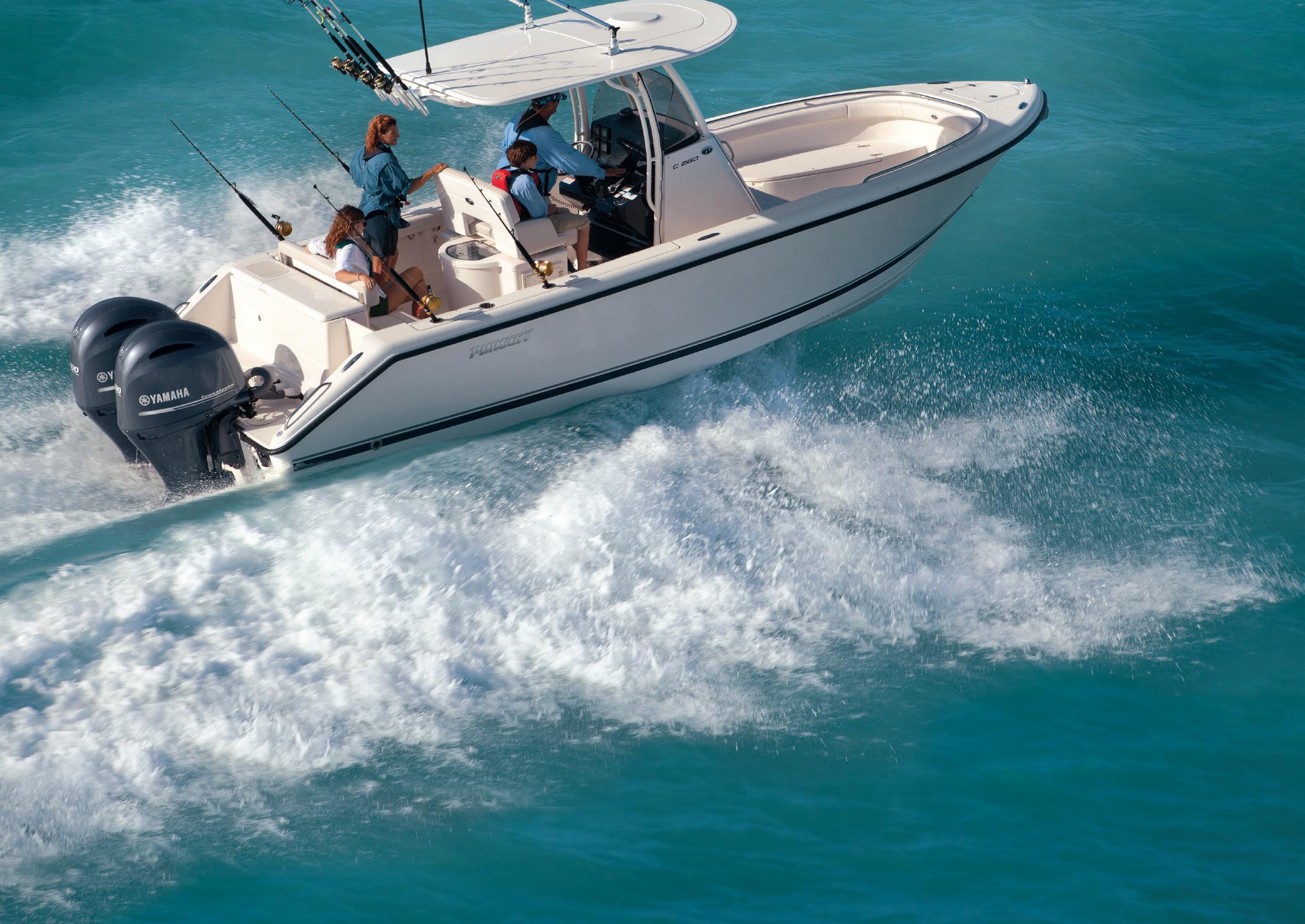





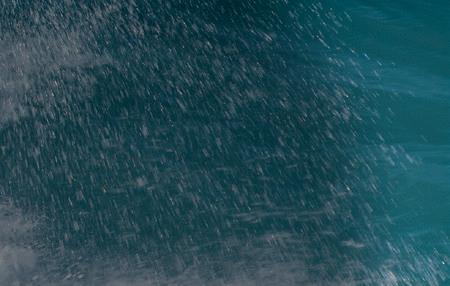






from other anglers. The Owens downstream of Benton Crossing all the way to Crowley Lake is not open, however, so make sure you stay upstream of the bridge.
Nearby, Hot Creek is a world-class fly-fishing stream that is open yearround, and winter is actually a good time to hit it because the weeds that are so prevalent all summer have significantly backed off, allowing better drifts through the channels winding through the salad. Hot Creek is one of the most trout-dense streams in the state, and it also gives up trophy trout from time to time. Check with the local tackle shops for the latest on conditions and what’s working, especially when it comes to the flyfishing spots.
Bass fishing in the Owens Valley is the most underutilized angling resource in the Eastern Sierra – to non-locals, anyway – and it can offer nonstop action when you get into them. Just about every pond that looks “bassy” in the valley holds bass – for example, Millpond and Buckley Ponds in the Bishop area – but anglers looking for a shot at top-notch numbers should hit the lower Owens River itself.
The best resource for bass fishing in the area is Nick Lara at Mac’s Sporting Goods (macssportinggoods .com) in Bishop. He also carries a large selection of bass gear handpicked for the area, runs local bass tournaments and really prefers fishing for bass to trout. Stop by the shop for the latest intel before hitting the water. When I first decided to focus on Owens Valley bass, Lara said the approach is simple: just fish the same water (you’d fish for trout) but use bass stuff.
I took it from there, and my partner and I combined for almost 70 largemouth and smallmouth in half a day on the Owens River between Big Pine and Independence. Then my brother and his buddy did the same on the way up the next day. That time, most of our damage was



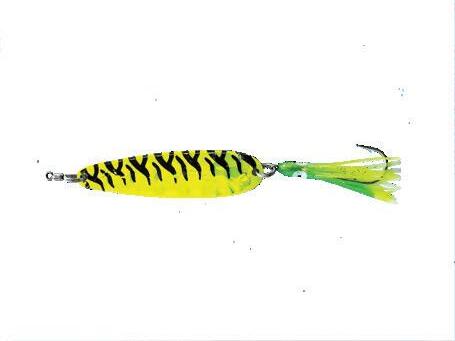





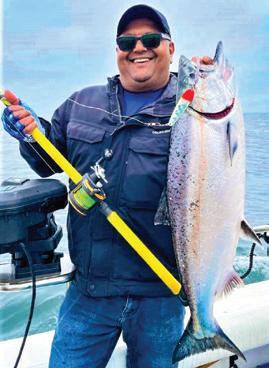

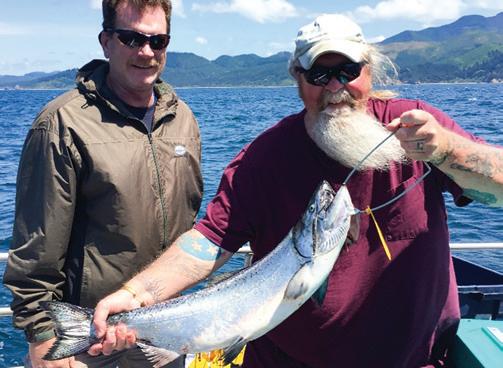



done with squarebill crankbaits, tube jigs, lipless cranks and jerkbaits, in that order.
We’ve yet to replicate that first outing in any of those that followed, but we never get skunked and have also done well with underspins, creature baits on a weedless jighead and Ned rigs. To me, the best part about this brand of fishing is the thought that a monster Owens River brown trout might chase down one of these bass baits we are throwing on heavier gear.
Now keeping close tabs on Owens Valley bass fishing, I can confirm that both flavors of bass, along with bluegill and even catfish, can be caught from Lone Pine to Bishop. So always remember to bring some bass gear if you plan on spending time fishing in the valley.
For any of this, it’s very important to consult the CDFW regs before your first cast because the rules can be especially tricky to follow in winter. CS








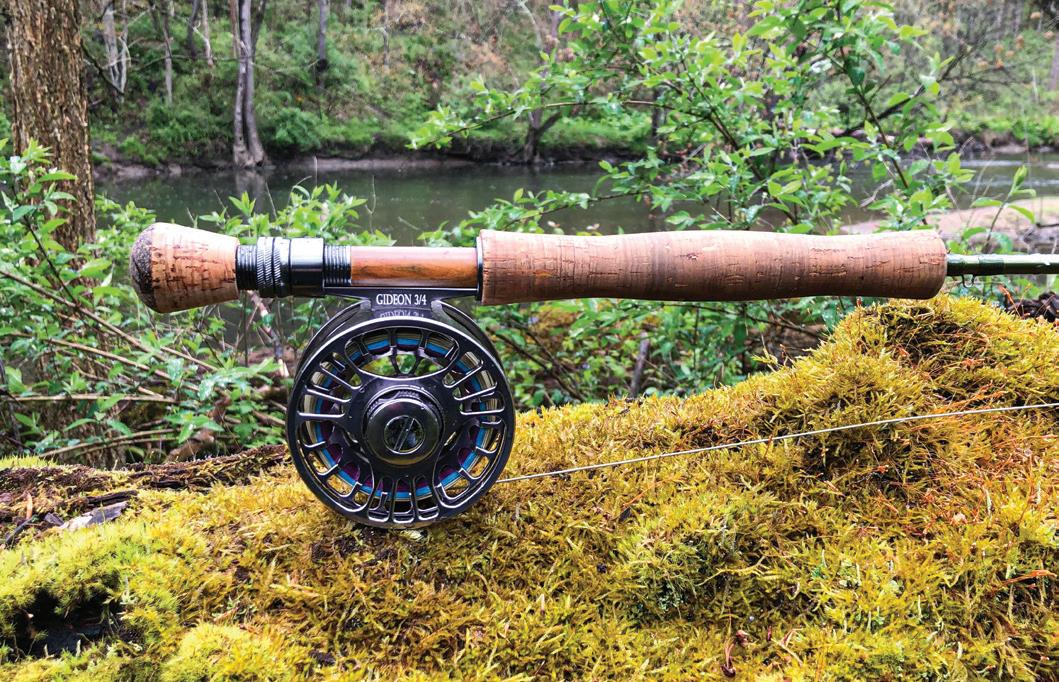







By Cal Kellogg
Between guiding trout anglers and creating trout fishing videos, I visit a long list of Golden State lakes every year. During the winter and early-spring months, when high-country lakes are locked in snow and ice, Northern California’s Lake Amador has long been a favorite destination of mine.
Dwarfed by large trout powerhouses like Lakes Berryessa and Camanche, Amador is often overlooked by outdoor media outlets as well as the vast majority of NorCal trout anglers.
Lake Amador offers up three species of trout that grow to massive proportions, as well as some rural foothill charm only a short drive from the valley floor and communities such as Stockton and Sacramento.
AMADOR AT GLANCE
Lake Amador formed in 1965 when a large earthen dam was constructed on Jackson and Carson Creeks. The lake belongs to the Jackson Valley Irrigation District and is located in Amador County, about 40 miles northeast of Stockton.
When at full capacity, Amador boasts nearly 425 acres of surface area and roughly 13 miles of shoreline. In
terms of surface acres, the lake is quite small by Sierra foothills’ standards.
But from a fishing perspective, Amador seems larger than it is because the main body consists of a deep bay in front of the dam, backed up by a series of large coves coming off the main creek channel to the north and south. Beyond the main body and moving northeast, the Jackson Creek Arm forms a long, narrow sweep that maintains reasonably deep water all the way to the headwaters of the lake.
In 1973, the Lockhart Family took over concessions at the lake and created Lake Amador Resort (209-274-4739; lakeamador.com).
These days the resort features 150 campsites, a swimming pond, café, boat launch, and more.
The Lockharts have always run the resort with a fishing focus. Early on they built their own trout hatchery, where they now raise three different strains of fish. The centerpiece species is the Donaldson cuttbow. These fish are 30 percent steelhead, 50

percent rainbow trout and 20 percent cutthroat trout. Cuttbows prefer to stay high in the water column, put up a vigorous fight when hooked and provide great table fare.
Standard rainbows are raised at the hatchery, along with “Amador golds.” These are rainbows with
bright yellow coloration; they’re known at other lakes as lightning trout or palomino trout.
In 2023-24 the Lockhart family stocked about 30,000 total pounds of trout into the lake. While some of the trout are pan size, many of the fish stocked range from big to massive.
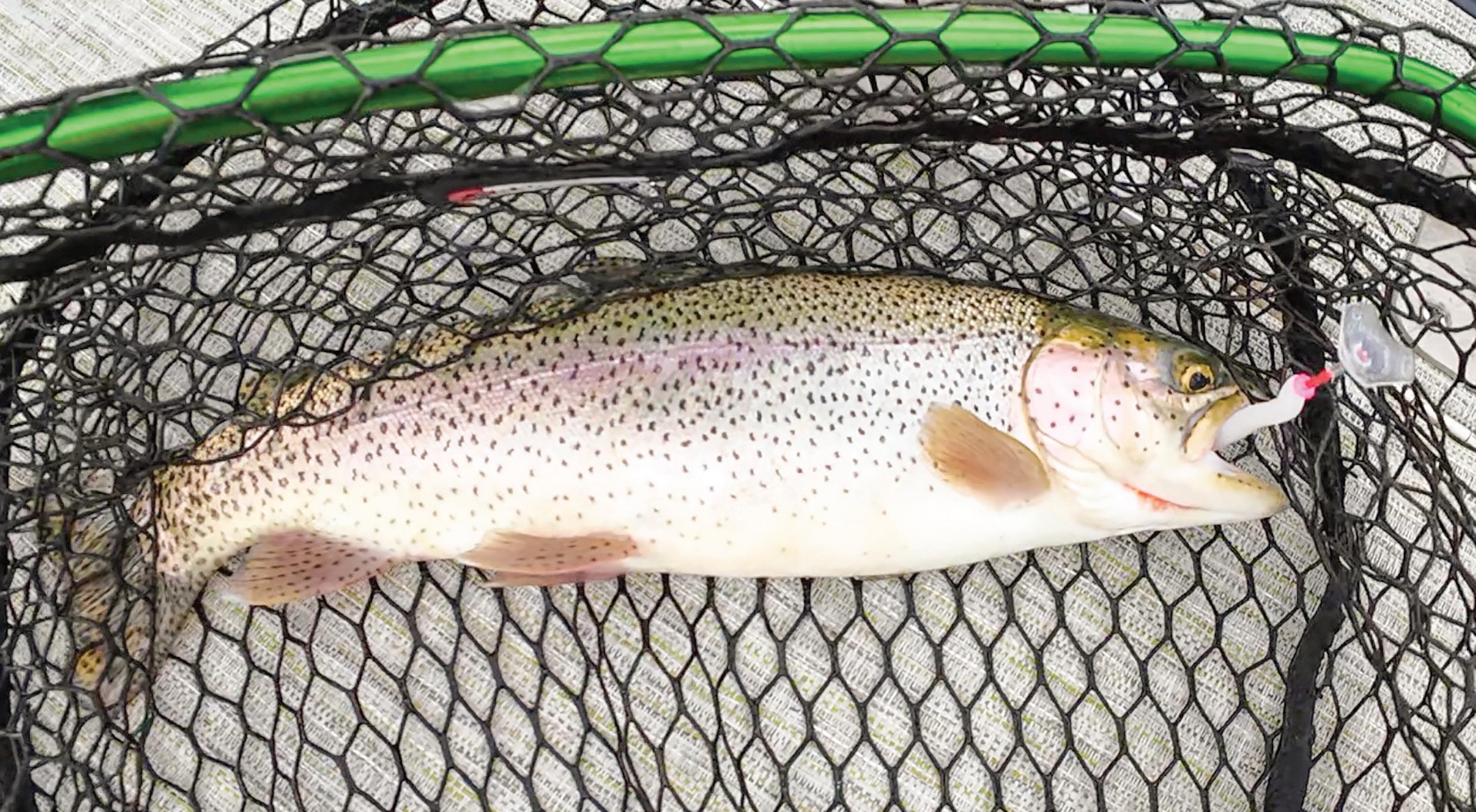
Juan Garcia set the lake record for cuttbows with a huge 20.1-pound trout in 2020. That same year Jeremy Silva set the mark for rainbows with a 19.3-pound beast. The current record Amador gold trout weighed in at 13.04 pounds and was caught by Stephen Blecha in 2022.
While trout are a big part of the fishing focus at Lake Amador, the reservoir boasts huge largemouth bass that commonly reach the 10-pound mark. The lake-record 17.10-pounder was caught by Tim Kamura in 1986.
Catfish also reach impressive size at Amador, as illustrated by Joel Isaac’s lake-best channel cat weighing in at 39.60 pounds! Joel caught his monster in 2020.
In my nearly two decades as the managing editor of the Fish Sniffer magazine, thousands upon thousands of photos came across my desk. The hands-down most impressive freshwater fish photo I ever saw came from Lake Amador.
It wasn’t a photo of a bass or trout or even a giant catfish. It was a 61-pound carp that a trout angler landed on spinning gear while soaking a single white Power Egg. The monster fish was weighed and released back into the lake.
A 60-pound saltwater fish is impressive, but a 60-plus-pounder of any species caught in a freshwater fishery is nearly unheard of!
October marks the beginning of trout planting and trout season at Lake Amador. When cool conditions arrive early in some years, releases begin around the middle of the month, but you can always count on plants getting started by Halloween.
The trout season continues through the winter and spring, typically wrapping up as May gives way to June.
Trout are still trout wherever they are found, but it seems like every destination has its own quirks and particulars when it comes to catching fish consistently, and this is very true for those looking
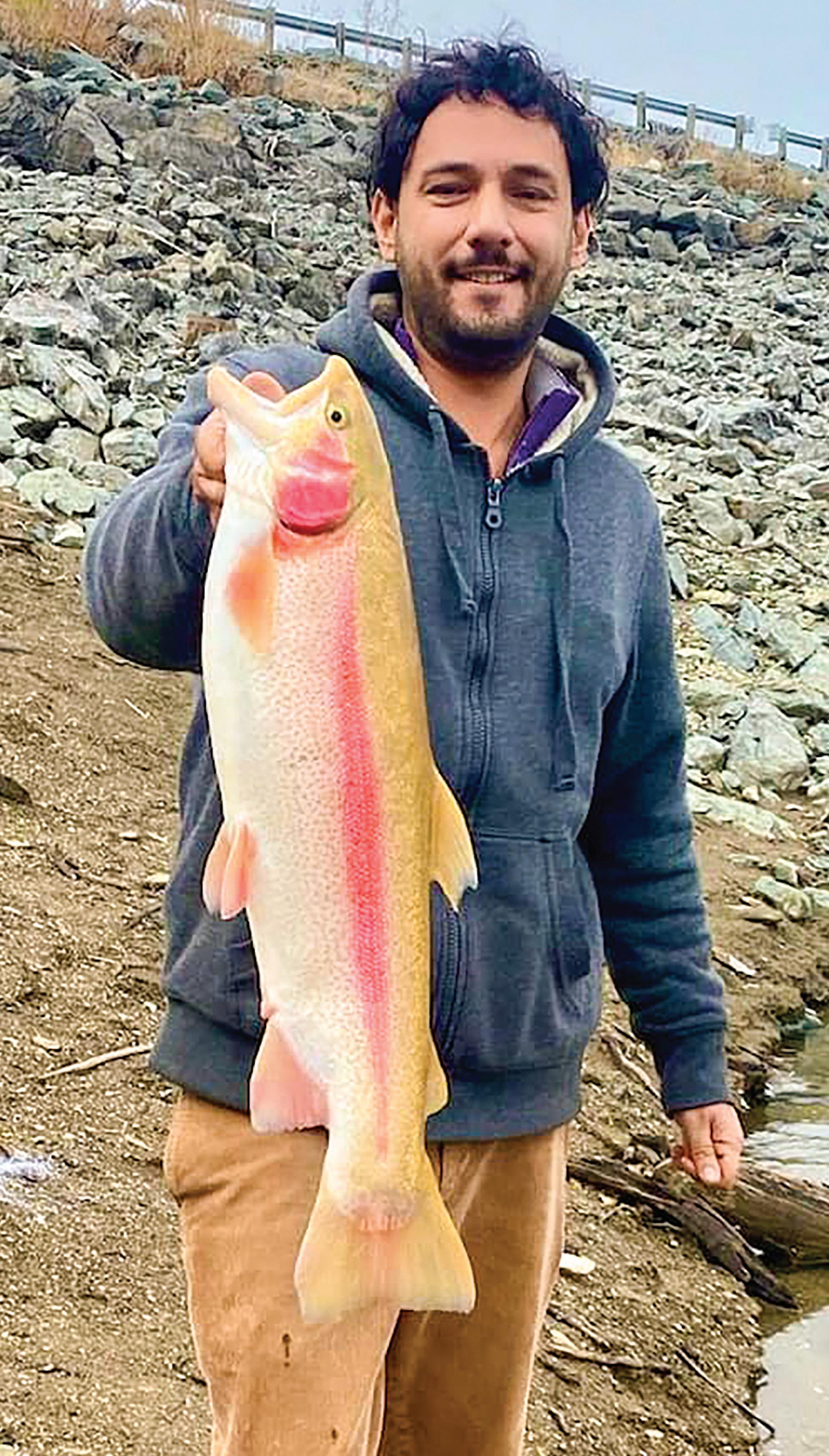
to score at Amador. Bank anglers, float tubers, kayakers and boaters all have the potential to score well.
One of my most memorable trips to the lake took place more than 15 years back when my buddy Joe Semas and I bank fished here. We checked in at the café, parked and walked down to the north corner of the dam. Armed with spinning rods, we each tossed out small balls of PowerBait. When no action came after 20 minutes or so, we rigged up our second spinning rods for casting. Joe went with a small spoon, while I opted for a clear casting bubble filled with water and trailed by a tiny size 10 black Woolly Bugger.
I made a long cast and started making an erratic retrieve. Seconds later, a handsome 20-plus-inch cuttbow crushed the tiny fly and I managed to land the fish after a wild fight. When I hooked another cuttbow a few casts later, Joe scrambled to rig up with a casting bubble and fly.
For the next three hours we were in trout fishing heaven, as our small flies, fished right under the surface, tempted trout after trout. If I remember correctly, we kept a total of six fish to
about 4 pounds and released a bunch more, all while boaters working just beyond our position on the bank went fishless pulling standard trout spoons and plugs.
That overcast day, the trout wanted a small dark fly worked slowly with plenty of pauses and twitches. Joe and I stumbled onto the correct recipe for success and the reward was sweet.
The key things for bank anglers to remember are that Amador’s trout tend to be most active near the surface, and more often than not they like small offerings. This is true even for massive double-digit fish.
If you are working artificials, take a cue from Joe and I: Keep your offering within 2 or 3 feet of the surface. If you are going to soak floating baits off the bottom, don’t cast too far from the bank. Much of the shoreline at Amador is steep, so if you cast very far off the bank, your bait will be too deep.
I’d say you want your floating dough bait no more than 10 feet deep most of the time. And don’t use a big blob of bait. Use a tight little ball a quarter inch or less in diameter. Remember, the most

popular bait among many seasoned Amador bait anglers is a single white or chartreuse Power Egg.
Most of the time light-colored baits and lures outperform darker-colored offerings, but not always. At times you can score well with dark or even black lures when the sky is overcast and the light level low.
You don’t hear a lot about anglers fishing from float tubes at most California reservoirs these days, but those who use them at Amador score well. Some of them are diehard fly savants who slowly troll small, lightcolored streamers and wet flies, while others are spin anglers who have graduated from the bank to tubes.
The latter group slow troll with lures at times, but the most consistently successful anglers work with small, light-colored flies, white marabou crappie jigs and Power Eggs. They typically work in front of the dam, either drifting in the breeze or working their swim fins just hard enough to make forward progress.
As I was leaving Amador after a successful boat fishing trip last week, I watched a tuber hook up on a fly rod as I was driving across the dam. Based on the splashes the trout made, I think it was a pretty husky fish!
To the casual observer, trolling from a boat or kayak looks about the same, but day in and day out at waters like Amador, where the trout can be finicky and shy, kayaks will almost always outfish a boat.
Not only does a kayak offer a smaller footprint and less disturbance than a boat, but they also allow you to work in smaller, shallower areas like the very backs of coves and narrow creek channels.
With the tendency of Amador trout to hold in shallow nearshore areas, fishing from a pedal kayak can really give you an edge.
But regardless of whether you are trolling from a kayak or boat, you’ll want to tweak your offerings a little to match the temperament of Amador trout. These days, most


trout anglers are fascinated with speed trolling with both spoons and plugs. At times trout respond to lures moving in excess of 3 mph, but not all the time or even a majority of the time. Too many anglers are spending too much time power trolling, and it is hurting their scores.
For consistent trolling success at Amador, it’s time to do some thinking:
• Think shallow, meaning your lures should be working 10 feet deep or less.
• Think slow, meaning 2.2 mph or slower most of the time.
• Think small, meaning lures less than 2 inches in length.
• Think light or bright colors most of the time – white, yellow, chartreuse, orange or hot pink. I’ve hit Lake Amador several times this fall and winter, and I’ve been scoring pretty well. My overall top offerings have been white or orange soft plastics. Some days the fish want Trout Trix Minnows, while on other days they go for a 2-inch grub in the same colors.
The second-best offering I’ve run is a small 1/8-ounce bright-orangebacked and silver-bottomed spoon. Bringing up the rear has been a small No. 8 yellow and red Woolly Bugger

trolled just under the surface.
When trolling from a power boat, some of the largest trout my partner and I have hooked have come while running a side planer. Again, Amador trout tend to be shy, so it makes sense to get your offering away from the boat, which makes a difference.

WEATHER EFFECTS AND GEAR
Heavy rain can muddy the water at Lake Amador. Stained water doesn’t bother me. The trout locate lures by feeling the vibrations the lures put out with their lateral lines. If they like the vibration, they move in closer and closer until they catch sight of the lure.
For both bait anglers and trollers, utilizing scent when the water is cold and muddy makes sense. If there is anything you can do to give yourself an edge, you should do it. Scent definitely falls into that category.
Finally, when you fish Amador, make sure your line is fresh, your knots are perfect and you bring a good net. You never know when a 19- or 20-pound trout will come knocking; you want to be ready to take full advantage of the opportunity when a trophy fish shows up! CS
Editor’s note: Cal Kellogg is a longtime Northern California outdoors writer. Subscribe to his YouTube channel Fish Hunt Shoot Productions at youtube.com/ user/KelloggOutdoors.













• Complete selection of fishing and crabbing gear and the finest line-up of bait in Newport!
• Ice machine operated by Visa or cash - bags fill in 15 seconds
• Vacuum packing & freezing of your catch available
• Easy access boat parking
• In-house reel repair
• One-stop shop for any angler
• Rentals: crab trabs and jetty rod setups


★ New patented EASY to use Bobber With A Brain Jr., ONLY automatic slip bobber in the world that requires no line stopper! You can fish 1 & 2 feet off the bottom automatically any depth, even 50 feet deep and it will not drift in 30 mph wind or jet ski waves!
★ Works in combination with any slip sinker and allows you to fish on and off the bottom at the same time on the same crappie or perch type rig!
★ Sold in three packs on e-bay and website: BobberWithABrain.net or SmartestTackle.com
★ Questions answered by Frank, inventor at Stackle23@msn.com



By Mark Fong
Imust confess that as I listen to the wind howling and see the rain coming down, I have a bad case of cabin fever.
If you are an outdoors lover, I am sure you know what I am talking about; it happens to most of us every winter. This time of year can feel like it may never end. There are only so many times that I can reorganize my fishing tackle. The only solution, if even for a minute, is a summer flashback.
Last August, smack dab in the middle of a typical Sacramento-area heat wave, I arranged to meet up with fishing guide Dakota Townley for a morning of kokanee fishing at Whiskeytown Lake. I had never been to Whiskeytown before, but I knew about its reputation as perhaps the premier kokanee fishery in Northern California. In speaking with Townley, he told me the kokanee were on a great bite. The fish were big and he promised we would be limited out before the temperature got too hot.
Whiskeytown is located just a short drive west of Redding on State Route 299. Accompanying me on this fishing adventure was my buddy Paul Boudreau, and also joining us was Dakota’s uncle Rob. When we arrived at the Whiskey Creek Boat Launch there were a number of other boats already in the parking lot. This was not surprising to me,


as the fishing had been really good throughout the summer.
After launching Dakota’s Willie jet boat, we made our way downlake towards the highway bridge. As I helped Dakota ready our gear, Paul and Uncle Rob were in the middle of a deep conversation regarding their mutual fascination for hot rod cars.
After a brief idle, Dakota shut down the big motor and started the troll. Dakota handed me an 8-foot kokanee trolling rod paired with a linecounter reel. On the business end of the line he attached a Wonder Bread-colored Kevin Brock Koko Krush Kokanee Flasher and a pink Koko Spin Lure.
After tipping the hooks of the KoKo Spin with corn, I dropped my rig back behind the boat until the linecounter read 30 feet. Dakota then clipped the line into the downrigger
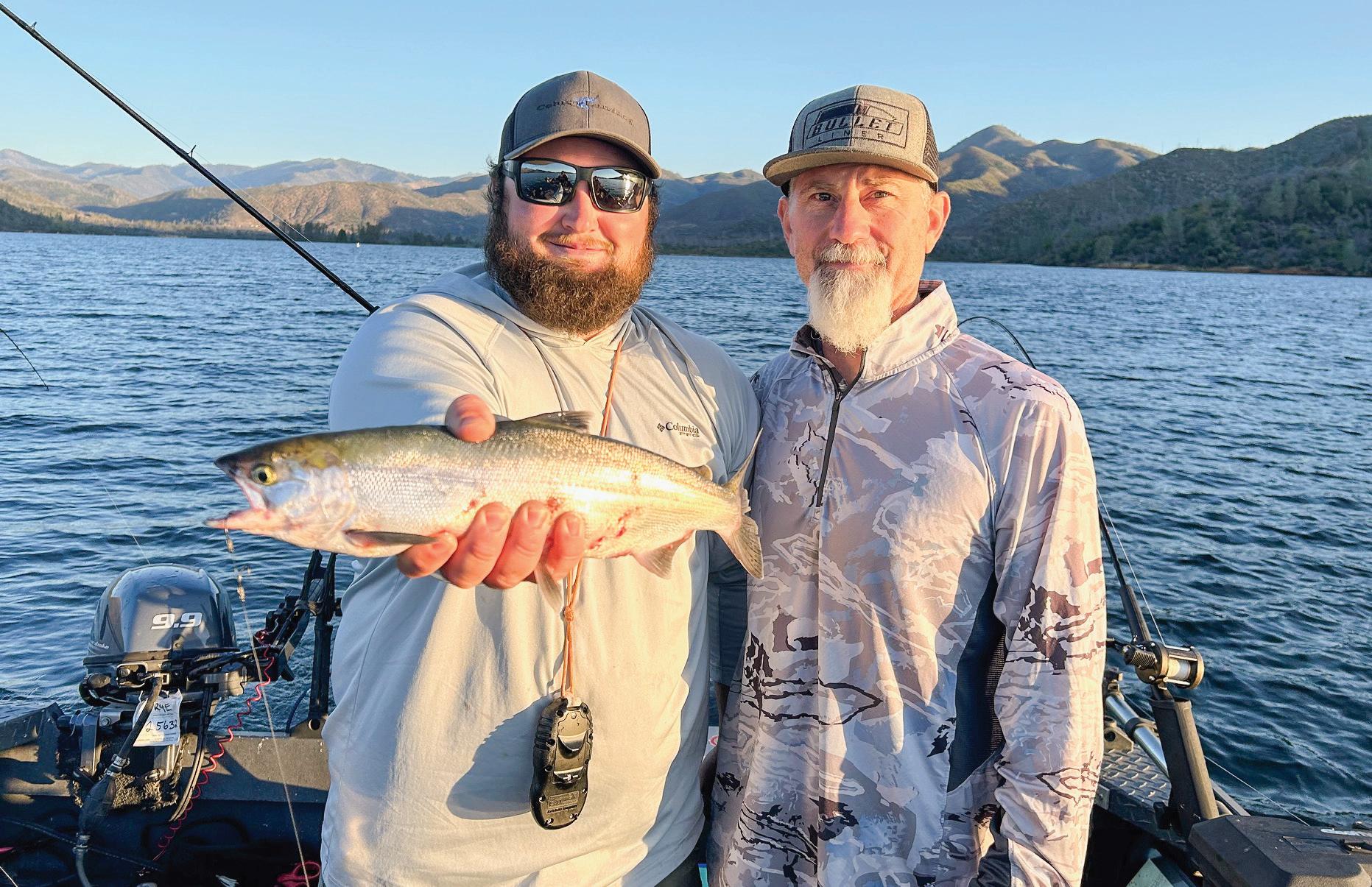

release and set the depth of the downrigger ball at 55 feet. Soon we had all our rods in the water and were ready for action.
As I enjoyed the cool of the morning, I was caught off guard by the shouts of “Fish on!” Paul was first up and the grin on his face confirmed that he was hooked up with a nice kokanee. After the fish popped off the downrigger release it headed for the surface, where it thrashed about in an attempt to get away. Paul worked the kokanee carefully to the side of the boat, where it made several spirited surges before Dakota put the fish in the net.
When I saw the fish, the first thing
I noticed was how big it was and how thick it was across its back. This fish was no dink and it was a perfect example of the quality of kokanee that Whiskeytown has become known for.
Our morning was off to a quick start, as we had our first fish in the boat after fishing for less than 10 minutes. As we made our way under the bridge and into the main body of the lake, the action really picked up. It was chaos as Uncle Rob and I were both hooked up at the same time, making Dakota scramble to net our fish. This was the first of many double hookups. It seemed like as fast as we could get our rods rebaited and back in the water, we were hooked
up again. If the bite slowed, Dakota would troll back through the area where we were getting bit and, like clockwork, the action would resume.
True to his word, Dakota had us limited out in just a few hours. Most of our kokanee were in the 15- to 16-inch range with a few just north of 17. This was truly an awesome day of nonstop action that produced a bunch of greateating kokanee fillets for the smoker.
Whiskeytown had definitely lived up to its reputation. Sadly, if summer could only last a bit longer, as I remain in the winter doldrums. CS
Editor’s note: To book a trip with Townley or to learn more, you can follow him on Facebook at Dakota Townley or contact him directly at (530) 680-3717.


By Scott Haugen
Ihunted a slough on a local river for the second time in five days. The wind was perfect, the decoys looked great and though ducks were flying, they were reluctant to drop into the spread.
After making multiple decoy changes my buddy and I relocated to
another slough a few hundred yards downstream. We quickly killed limits of mallards and wigeon.
The first spot was good; it was one we’ve been hunting for years and had shot limits on earlier in the week, but there were other hunters on the river that day – lots of them. Rather than sit and hope the other hunters shot their birds and moved on, we decided
to put some distance between us and seek a more secluded spot. The plan worked on this, the last weekend of duck season.
THE FINAL DAYS
I can’t believe duck season is already winding down. It’s depressing. I love duck hunting. But the final weeks are also my favorite time to get after these awesome birds.
Late-season ducks are educated. They’ve been hunted since September in parts of Canada and Alaska. They’ve migrated down the continent and gotten shot at all the way. Ducks are heavily hunted on their wintering grounds. And for those of us who live in temperate climates, we might even see an actual influx of ducks as they begin their northerly migration back to the nesting grounds, thereby mixing with wintering duck populations, which makes hunting them even more challenging.
If you’re flustered with the difficulties of late-season duck hunting, there are little things you can do to swing the odds in your favor. One key is being mobile. There are times when no matter how good your decoys and blind look, ducks won’t commit. If making decoy adjustments fails, changing locations may be in order. It might be as simple as moving to the other side of a pond, river or flooded field, or as inconvenient as packing up and driving an hour to another spot. If I question myself as to whether or not I should move, more times than not the answer is yes.
Being ready to move can be as easy as hunting over a small spread of decoys that can quickly be pulled and reset. Or it could mean stashing decoys in other hunting locales, so all you have to do is get to that spot and not have to worry about hauling decoys. This time of year I have a few places where I stash decoys so I don’t have to haul them around. Some are


By Tiffany Haugen
As with ducks, we like eating geese fresh, not freezing them and then cooking them up. Late in the season this means we’re eating waterfowl just about every day of the week for breakfast, lunch or dinner, and sometimes all three.
Before cooking any waterfowl, be sure all bloodshot tissues are removed and the meat is thoroughly cleaned. The higher the quality of the meat at the start, the better the final recipe will be. A lot of bad-tasting fowl is put on the cook when improper field care and cleaning are really to blame. The cleaner the meat, the more mild tasting and enjoyable waterfowl will be.
This sweet caramelized recipe is a big hit in our family. We’ve shared it with many friends who simply couldn’t believe they
were eating ducks and geese.
Two large goose breasts or four large duck breasts (about a pound)
¼ cup brown sugar
¼ cup soy sauce
2 tablespoons Worcestershire sauce
1 tablespoon balsamic vinegar
1 tablespoon garlic, puréed
½ teaspoon salt
½ teaspoon black pepper
2 tablespoons olive or coconut oil
One yellow onion, finely chopped Chives or green onion and chili peppers for garnish if desired
In a medium bowl, mix brown sugar, soy sauce, Worcestershire sauce, vinegar, garlic, salt and black pepper until thoroughly combined. Slice breasts across the grain into thin strips and add to the brine. Let

sit at room temperature 30 minutes (or refrigerate up to eight hours).
In a large skillet, sauté onions over medium-high heat in olive or coconut oil for two to three minutes. Push onions aside and add sliced waterfowl to the pan. Spread meat out in a single layer. Once meat begins to brown, turn over and brown the other side. Do not overcook ducks and geese, as the flavor will become stronger the more it’s cooked.
Once browned, mix meat with onion. Serve over rice and garnish with chives or green onions and hot peppers.
Editor’s note: For signed copies of Tiffany Haugen’s popular cookbook, Cooking Game Birds, visit scotthaugen.com.

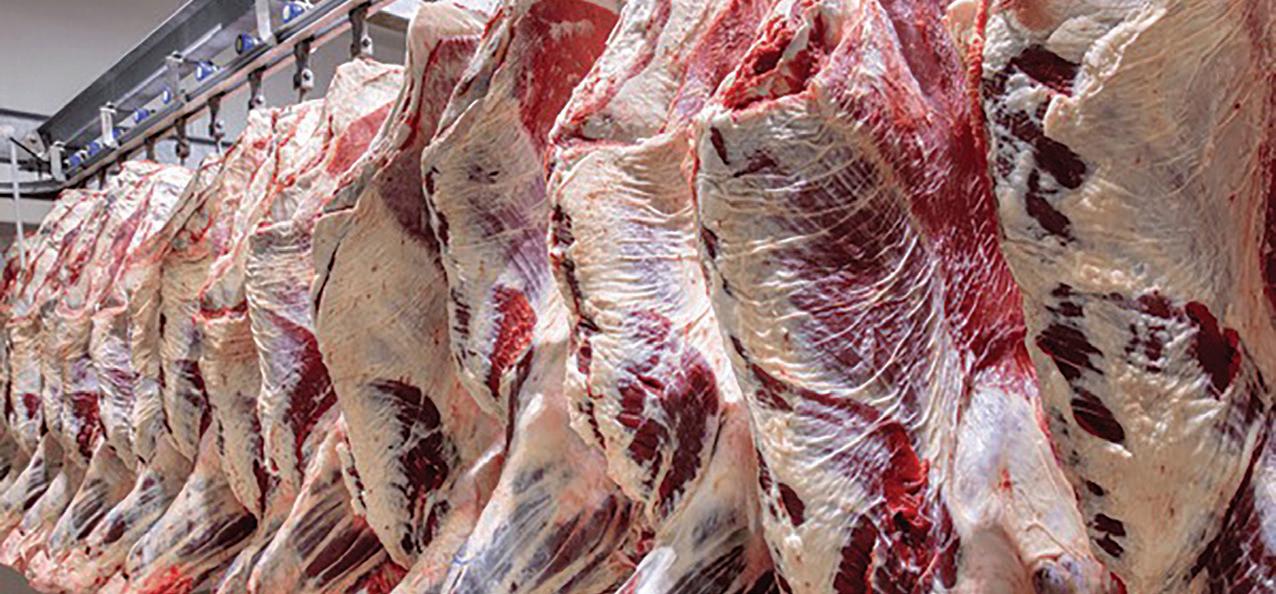
















on public land that I just hope don’t get stolen, or that fellow hunters at least respect them if they do find them. Moving to these spots turns a slow morning into a good day a few times each season for me.
Another reason to move could be the presence of fellow hunters. Hunt public grounds enough and you’ll have conflicts with hunters setting up too close to you. The competition from them calling to and shooting at
birds as they set up to swing into your decoys can be extremely frustrating. Rather than sit and grow more stressed, pick up and move; too many hunters too close to one another is a red flag to educated ducks.
Wherever you hunt, make sure your blind is brushed in so no edges show. Create depth with brush and natural habitat and avoid the blocky look that can be seen by keen-eyed ducks from miles away this time of year,
as vegetation has been hammered and broken down by storms. Make sure there are no black holes in the blind, especially if hunting from an A-frame.
I’m not a great caller but good enough. And I know when to shut up. Late in the season is when I hear the worst calling from fellow hunters. Call just enough to turn birds’ heads, then let the decoys do the work. Call if and when birds lose interest – no more – and avoid calling to hear yourself call. Desperate, incessant calling will quickly make wise ducks wiser.
This time of year I’m often pulling out my wing decoys, as everyone in the valley seems to be using them. Some hunters run at least one spinning-wing decoy on a jerk cord, sometimes two or three, and they continually yank on them as birds are working. If not concealed, the nonstop hand and arm movement from pulling the cord is another alert that will flare wary ducks. Sometimes less is more.
Late in the season I’m also checking out confined places to hunt. Creeks, little rivers, flooded corners of fields and even skinny sloughs can all be good. These micro habitats are great hiding places for wary ducks. While you might not get big numbers of birds hitting these hideaways, all you need is a handful to make for a great day.
Last season my buddies and I found a tiny creek full of mallards. It was late in the season and there was only room for a dozen decoys. We went on a Saturday when we knew public pressure on the nearby river would be high, keeping ducks in the air. With sub-gauges we quickly shot limits. I used a .410 and took seven greenheads in eight shots. It’s not a bragging point; rather, an example of how the gun fits the hunt and how, if you’re patient and let ducks work, you can shoot with consistent accuracy. If you’re going to hop on the

sub-gauge craze, make sure it will work in the places you plan to hunt. Hunting with a sub-gauge is a threepart process, so know your loads, your gun and let the birds work the decoys. If hunting public land where skybusting takes place all around you, a bigger bore might be a better choice. Be patient and hunt smart when using small-bore shotguns in the final weeks.
The best weeks of duck season are still ahead, and while birds are growing smarter by the day, it doesn’t mean acts of desperation are necessary. Hunt wisely, think things through, plan ahead and don’t be afraid to make small changes. That’s how you tackle the challenges of lateseason duck hunting. CS
Editor’s note: Scott Haugen is a waterfowl hunter of 48 years and a full-time writer for the past 23 years. Learn more at scotthaugen.com and follow him on Instagram.

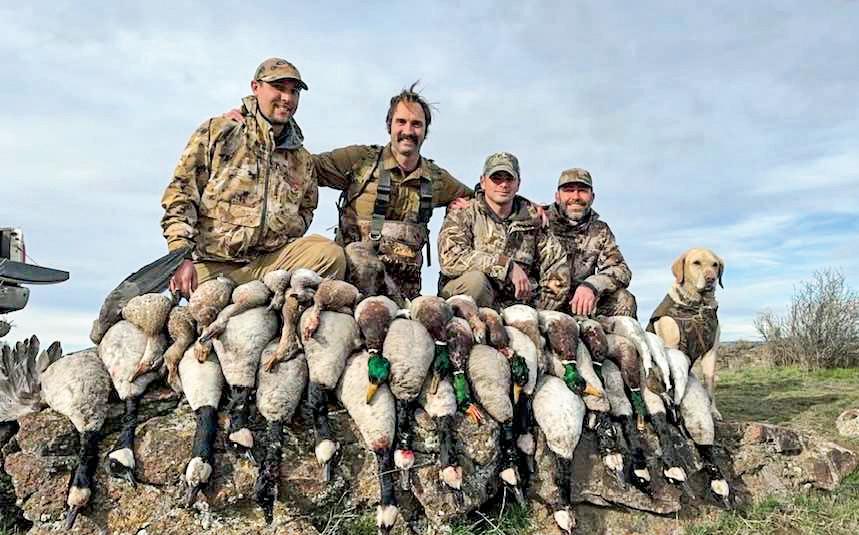


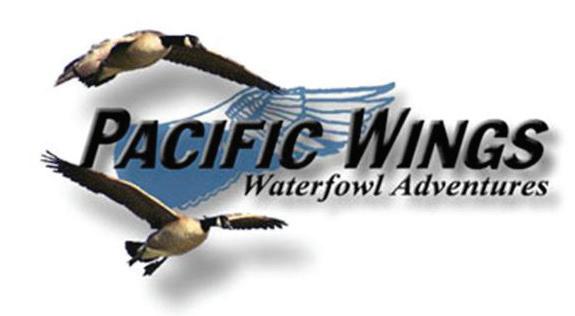





By Tim E. Hovey
Having grown up in California, I started my waterfowl journey in the Golden State by hunting ducks on and off, but I can clearly remember the first time I ever saw Canada geese.

I was fishing with my brother at a local lake in Central California. We were just about to jump on our bikes and head home when loud honking started over the trees we were standing under. Within seconds, a flock of over 100 Canada geese glided over the trees and loudly landed in
the lake in front of us. They were big, beautiful and noisy. And I knew I wanted to hunt them.
LEARNING ON THE FLY
It would be decades before I got to hunt geese with any regularity and begin to understand the specifics of

“Goose decoy setup patterns include the X, the U, the Y, the dipper and the string,” the author writes. “Ideally, you want to provide each hunter with adequate open space in front of them so that birds will approach and give them shooting opportunities, as well as to keep things safe.” (TIM E. HOVEY)
hunting these big birds. One of the things I realized early on is that successfully harvesting geese starts and ends with the decoy spread.
Canada geese typically migrate into California in the fall, with the migration beginning around late September to early October. The timing of this migration depends heavily on weather conditions and food availability in the north, where they originate. Canada geese will return to their breeding grounds in Canada by late March to early April. Some geese may remain in California year-round if food and weather conditions are favorable here.
Geese will gather in large flocks during the migration, and they prefer wetlands, lakes and agricultural fields. Hunters looking to hunt these
gatherings should spend some time scouting, observing flock patterns and locating resting and feeding areas. Patterning the birds goes a long way in successfully decoying them into range.
When I started looking into actively targeting geese during the season, I read all I could on how to successfully set up a goose decoy spread. It became clear to me early on that two things are required to bring geese close: the decoy spread shape and the types of decoys a hunter sets up.
Most duck hunters understand that setting up a successful decoy spread should include a vacant space directly in front of the hidden hunters. This space is left open
so that committed waterfowl can approach the open area to land in close proximity to the hunters. This decoy spread strategy is no different for geese.
Goose decoy setup patterns include the X, the U, the Y, the dipper and the string. All these setups depend heavily on the number of hunters hunting the decoy spread, as well as the amount of space you have for the hunt. Ideally, you want to provide each hunter with adequate open space in front of them so that birds will approach and give them shooting opportunities, as well as to keep things safe.
After investigating the different goose decoy spread shapes, I chose to go with what I’ve used when setting up for hunting ducks. For decades,

I’ve used the U-shaped decoy spread for waterfowl. Positioning the hunters at the bottom of the U, we would set our decoys in a U-shape from there. Additionally, setting up a U-shaped spread allows us to also attract ducks. This arrangement has worked for us with up to four hunters.
While there are numerous types of goose decoys on the market, the ones I prefer are full-body, silhouette and feeder decoys. When on approach, waterfowl will perceive safety in numbers, so seeing different types of decoys will put them at ease to get closer. Geese do the same thing.
Geese are large birds and will almost always approach a landing spot by flying into the wind. To give hunters ample opportunities, I like to set up the decoy spread with the wind at our backs, essentially blowing out over the open space in the U-shape.
Approaching birds will use the wind to land, pulling them into range for waiting hunters. If you’re looking to guide birds into range and where you want them, pay attention to the wind direction.
Recently, I was on a goose hunt where I learned something new. We were hunting from layout blinds and setting up decoys to accommodate six hunters. It was a guided hunt, and I was anxious to see how the guides set things up.
They set all six hunters in a slight crescent shape, with the decoys spread out in a kind of squat U-shape. The open space gave each hunter ample room to shoot. When we settled into hunting, I noticed that, much like when I set up my own spread, the wind was at our backs. That day we enjoyed great hunting success on Canada geese, lesser Canada geese and waterfowl.
The following day, we repeated the setup in a different spot. This time I noticed a guide picking up

However you approach your blind and set up your decoys, having the right shotgun shells is critical for success. “Canada geese are large birds, requiring heavier loads to bring them down,” Hovey writes. “We’ve done well using several different loads from Federal. All shells should be 3-inch.” (TIM
and repositioning the decoys I’d just set down. When I asked about it, he gave me further insight into decoying geese. He mentioned that geese are not huge fans of being watched by other geese during their landing approach. He personally likes to face the full-bodied geese at a 90-degree angle to the open space. He also spaces the decoys out to give landing birds plenty of room.
During that hunt, I watched how these slight adjustments made a difference. We had experienced a slight lull in the action and were just about ready to pick things up when the guide spotted a pair of very large Canada geese approaching from out in front of us. During the lull, I had picked up three full-bodied decoys and placed them in bags already.
This left a sizeable gap in the left side of the U where I was set up.
With minimal calling the birds started to commit, but the wind had changed during the morning and was blowing more to my left. As the birds approached, they adjusted for the wind, putting them on a beeline right towards me. They approached over the setup, looking to land in the gap I had just created by removing the full-bodied decoys.
When they cupped their wings to land, I dropped the closest one and the hunter to my right killed the second one. My bird landed right where the three decoys had been standing only minutes before.
I now incorporate these slight decoy details to my setup just to increase the chances of bringing geese close. If the wind changes, we modify the setup to reflect that.
I also have friends who have very pricey, flocked decoys and those also seem to work well. They seem to provide more of a lifelike bird presentation than the plastic shell decoys can.
Canada geese are large birds, requiring heavier loads to bring them down. We’ve done well using several different loads from Federal. Our favorites are Speed-Shok, Black Cloud and Ultra Steel Double Stack. All shells should be 3-inch and loaded with shot ranging in size from T and BB to 2 and 4.
California Canada goose season varies by hunting zone, but a majority of the state is open from October 26 through January 31. Before you head out, reference the state’s hunting regulations to check on the different opening and closing dates, as well as the late-season opportunities in select zones.
Canada geese fall in the dark goose category and limits vary throughout the state. Also note the regs’ sub-bag limit for large Canada geese in some zones and special hunts. CS



Outfitters since 1994 100% American owned
















Echo, an 11-year-old pudelpointer, loves her alone time with author
By Scott Haugen
For hunters with gun dogs, the start of the new year marks the beginning of the end. For many of us, quail are tough to come by; their season usually burns to a slow end before the hard date deadline.
If you’re willing to brave the cold, chukar can still be chased, and their numbers are good in portions of their Western range this season. And there are still some pheasant hunting options – well, if you’re a California archer.
But if you’re a waterfowl hunter, the hunting just keeps getting better
as closing day rapidly approaches. Duck season is one of the most highly anticipated events of the year, and it’s coming to a close later this month.
For me and my dogs, the end of duck season is bittersweet. We’re hunting five days a week this month, sometimes more. We’re tired in those final days, but when it’s over, we’re depressed. It only takes a day to recover, then we realize it’s a long wait for next season.
IN THESE FINAL WEEKS of duck season, make the most of it with your dogs. The last three years I’ve slowed down, and I know the dogs love it.
And by slowing down I don’t mean hunting less. I mean hunting just as many days, just not being in a hurry to limit out and get home.
One thing I’ve been doing on many late-season hunts is trying to pick only drakes to shoot. This was spurred three seasons ago when an influx of Eurasian wigeons made their way into my home valley. When scouting reveals multiple Eurasian wigeons in a spot, shooting only drakes ups the odds of killing one. Rarely is there good enough light to decipher a drake Euro from an American wigeon drake, so it comes down to playing the odds by shooting football-shaped, big-headed drakes via their silhouettes. Shooting only drakes increases the chances of getting a prized Eurasian wigeon.
Picking drakes has greatly added hours to the amount of time the dogs and I get to hunt each day. Instead of being done in an hour or two, it might take six or seven hours to fill a limit. Sometimes we don’t even shoot limits. There’s very little shooting on drakeonly days, and we might look over thousands of birds in a day, but the dogs love it.
ONE OF MY FAVORITE parts of duck hunting is watching my dogs Echo and Kona spot birds and not take their eyes off them. They often see birds before I do. They tremble in anticipation the closer the ducks get. They look at my gun
barrel to see if I’m going to shoot. They know the difference between ducks and songbirds and raptors. I’m even convinced they can tell the difference between pintails and other ducks. If we get a sprig early, and watch hundreds of pintails continue to dive into the decoys, their ears don’t perk up like when wigeon or mallards start circling.
I also try to hunt many different places late in the season. Now, I’m pretty much done saving spots, waiting for bird numbers to build before hunting it. I like getting my dogs in as many new places as possible. This is not only good for their bodies, but great for their minds. From small creeks to big sloughs, farm ponds to flooded fields, we’re hunting all we can. The dogs love it and welcome the change.
Sometimes, if there’s been a
hard hunt, I’ll leave one dog home to recover. Then do the same the following day with the other dog. My dogs love the one-on-one attention they get on these hunts. They’re not competing with one another and they’re better behaved. It’s a solid way to wind down the season by optimizing and reinforcing desired behaviors.
If the water is frozen, I’ll often take Kona, my big, strong male, on a morning hunt. I won’t shoot a limit. Then I’ll run him home, grab lunch, then take Echo, my 11-yearold female, on an afternoon hunt. It’s better for her aging body to hunt once temperatures warm up.
By changing up the hunts, even swapping out dogs, I’ve learned one thing: Just like us, they want to be out hunting.
LAST SEASON I HAD one drake wigeon to go. The light was at my back, one of only a few times all season where I could see color on decoying birds. Kona and I sat over five hours. More than 700 ducks dumped into the decoys. I didn’t raise the gun one time. Kona knew what was going on. He loved laying there, watching birds work. With only a few minutes of shooting light left, Kona spotted a lone hen shoveler on the horizon. The duck flew right at us and I dropped it in the decoys. Kona delivered the bird to hand, then sat, looking at me. Kona knew the day was over. He was happy. CS
Editor’s note: Scott Haugen is a full-time writer. See his puppy training videos and learn more about his many books at scotthaugen.com and follow him on Instagram and Facebook.
